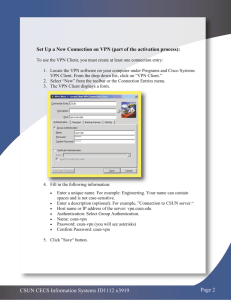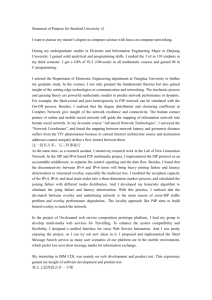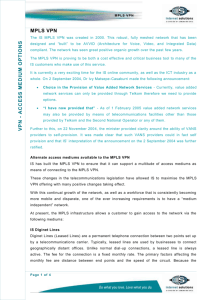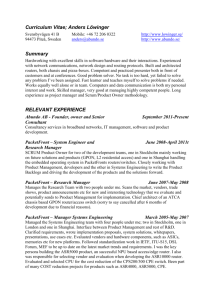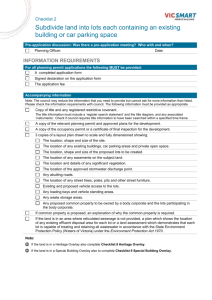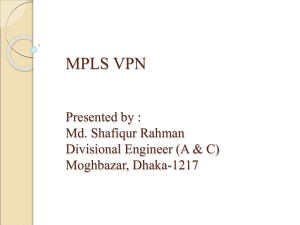ppt
advertisement
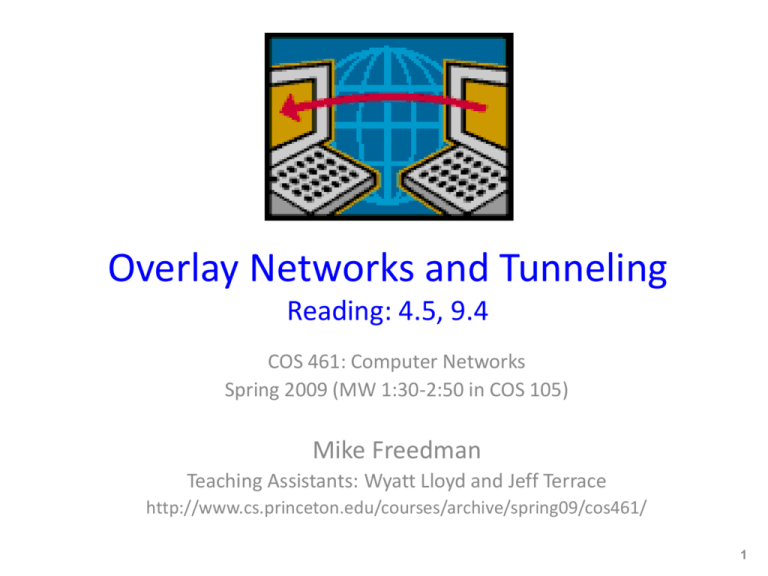
Overlay Networks and Tunneling Reading: 4.5, 9.4 COS 461: Computer Networks Spring 2009 (MW 1:30-2:50 in COS 105) Mike Freedman Teaching Assistants: Wyatt Lloyd and Jeff Terrace http://www.cs.princeton.edu/courses/archive/spring09/cos461/ 1 Goals of Today’s Lecture • Motivations for overlay networks – Incremental deployment of new protocols – Customized routing and forwarding solutions • Overlays for partial deployments – 6Bone, Mbone, security, mobility, … • Resilient Overlay Network (RON) – Adaptive routing through intermediate node • Multi-protocol label switching (MPLS) – Tunneling at L2.5 2 Overlay Networks 3 Overlay Networks 4 Overlay Networks Focus at the application level 5 IP Tunneling to Build Overlay Links • IP tunnel is a virtual point-to-point link – Illusion of a direct link between two separated nodes Logical view: Physical view: A B A B tunnel E F E F • Encapsulation of the packet inside an IP datagram – Node B sends a packet to node E – … containing another packet as the payload 6 Tunnels Between End Hosts B Src: A Dest: B Src: C Dest: B Src: A Dest: B A C Src: A Dest: C Src: A Dest: B 7 Overlay Networks • A logical network built on top of a physical network – Overlay links are tunnels through the underlying network • Many logical networks may coexist at once – Over the same underlying network – And providing its own particular service • Nodes are often end hosts – Acting as intermediate nodes that forward traffic – Providing a service, such as access to files • Who controls the nodes providing service? – The party providing the service – Distributed collection of end users 8 Overlays for Incremental Deployment 9 Using Overlays to Evolve the Internet • Internet needs to evolve – IPv6 – Security – Mobility – Multicast • But, global change is hard – Coordination with many ASes – “Flag day” to deploy and enable the technology • Instead, better to incrementally deploy – And find ways to bridge deployment gaps 10 6Bone: Deploying IPv6 over IP4 Logical view: Physical view: A B IPv6 IPv6 A B C IPv6 IPv6 IPv4 Flow: X Src: A Dest: F data A-to-B: IPv6 E F IPv6 IPv6 D E F IPv4 IPv6 IPv6 tunnel Src:B Dest: E Src:B Dest: E Flow: X Src: A Dest: F Flow: X Src: A Dest: F data data B-to-C: IPv6 inside IPv4 B-to-C: IPv6 inside IPv4 Flow: X Src: A Dest: F data E-to-F: IPv6 11 Secure Communication Over Insecure Links • Encrypt packets at entry and decrypt at exit • Eavesdropper cannot snoop the data • … or determine the real source and destination 12 Communicating With Mobile Users • A mobile user changes locations frequently – So, the IP address of the machine changes often • The user wants applications to continue running – So, the change in IP address needs to be hidden • Solution: fixed gateway forwards packets – Gateway has a fixed IP address – … and keeps track of the mobile’s address changes www.cnn.com gateway 13 IP Multicast • Multicast – Delivering the same data to many receivers – Avoiding sending the same data many times unicast multicast • IP multicast – Special addressing, forwarding, and routing schemes 14 MBone: Multicast Backbone • A catch-22 for deploying multicast – Router vendors wouldn’t support IP multicast – … since they weren’t sure anyone would use it – And, since it didn’t exist, nobody was using it • Idea: software implementing multicast protocols – And unicast tunnels to traverse non-participants 15 Multicast Today • Mbone applications starting in early 1990s – Primarily video conferencing, but no longer operational • Still many challenges to deploying IP multicast – Security vulnerabilities, business models, … • Application-layer multicast is more prevalent – Tree of servers delivering the content – Collection of end hosts cooperating to delivery video • Some multicast within individual ASes – Financial sector: stock tickers – Within campuses or broadband networks: TV shows – Backbone networks: IPTV 16 Case Study: Resilient Overlay Networks 17 RON: Resilient Overlay Networks Premise: by building application overlay network, can increase performance and reliability of routing Princeton app-layer router Yale Two-hop (app-level) Berkeley-to-Princeton route Berkeley http://nms.csail.mit.edu/ron/ 18 RON Circumvents Policy Restrictions • IP routing depends on AS routing policies – But hosts may pick paths that circumvent policies USLEC me ISP PU Patriot My home computer 19 RON Adapts to Network Conditions B A C • Start experiencing bad performance – Then, start forwarding through intermediate host 20 RON Customizes to Applications B A bulk transfer C • VoIP traffic: low-latency path • Bulk transfer: high-bandwidth path 21 How Does RON Work? • Keeping it small to avoid scaling problems – A few friends who want better service – Just for their communication with each other – E.g., VoIP, gaming, collaborative work, etc. • Send probes between each pair of hosts B A C 22 How Does RON Work? • Exchange the results of the probes – Each host shares results with every other host – Essentially running a link-state protocol! – So, every host knows the performance properties • Forward through intermediate host when needed BB A C 23 RON Works in Practice • Faster reaction to failure – RON reacts in a few seconds – BGP sometimes takes a few minutes • Single-hop indirect routing – No need to go through many intermediate hosts – One extra hop circumvents the problems • Better end-to-end paths – Circumventing routing policy restrictions – Sometimes the RON paths are actually shorter 24 RON Limited to Small Deployments • Extra latency through intermediate hops – Software delays for packet forwarding – Propagation delay across the access link • Overhead on the intermediate node – Imposing CPU and I/O load on the host – Consuming bandwidth on the access link • Overhead for probing the virtual links – Bandwidth consumed by frequent probes – Trade-off between probe overhead and detection speed • Possibility of causing instability – Moving traffic in response to poor performance – May lead to congestion on the new paths 25 We saw tunneling “on top of” IP. What about tunneling “below” IP? Introducing Multi-Protocol Label Switching (MPLS) 26 Why Tunnel? • Reliability – Fast Reroute, Resilient Overlay Networks (Akamai SureRoute) • Flexibility – Topology, protocol • Stability (“path pinning”) – E.g., for performance guarantees • Security – E.g., Virtual Private Networks (VPNs) • Bypassing local network engineers – Censoring regimes: China, Pakistan, … 27 MPLS Overview • Main idea: Virtual circuit – Packets forwarded based only on circuit identifier Source 1 Destination Source 2 Router can forward traffic to the same destination on different interfaces/paths. 28 MPLS Overview • Main idea: Virtual circuit – Packets forwarded based only on circuit identifier Source 1 Destination Source 2 Router can forward traffic to the same destination on different interfaces/paths. 29 Circuit Abstraction: Label Swapping D A 1 Tag Out New A 2 2 3 D • Label-switched paths (LSPs): Paths are “named” by the label at the path’s entry point • At each hop, MPLS routers: – Use label to determine outgoing interface, new label – Thus, push/pop/swap MPLS headers that encapsulate IP • Label distribution protocol: responsible for disseminating signalling information 30 Reconsider security problem 31 Layer 3 Virtual Private Networks • Private communications over a public network • A set of sites that are allowed to communicate with each other • Defined by a set of administrative policies – Determine both connectivity and QoS among sites – Established by VPN customers – One way to implement: BGP/MPLS VPN (RFC 2547) Layer 2 vs. Layer 3 VPNs • Layer 2 VPNs can carry traffic for many different protocols, whereas Layer 3 is “IP only” • More complicated to provision a Layer 2 VPN • Layer 3 VPNs: potentially more flexibility, fewer configuration headaches 33 Layer 3 BGP/MPLS VPNs VPN A/Site 2 10.2/16 VPN B/Site 1 10.1/16 CE B1 P1 2 10.2/16 CEA2 1 CEB2 PE2 CE B1 BGP to exchange routes P2 PE1 CEA1 PE3 P3 VPN B/Site 2 MPLS to forward traffic CEA3 10.3/16 CEB3 10.1/16 VPN A/Site 1 VPN A/Site 3 10.4/16 VPN B/Site 3 • Isolation: Multiple logical networks over a single, shared physical infrastructure • Tunneling: Keeping routes out of the core 34 High-Level Overview of Operation • IP packets arrive at PE • Destination IP address is looked up in forwarding table PE2 PE1 PE3 • Datagram sent to customer’s network using tunneling (i.e., an MPLS label-switched path) 35 BGP/MPLS VPN key components • Forwarding in the core: MPLS • Distributing routes between PEs: BGP • Isolation: Keeping different VPNs from routing traffic over one another – Constrained distribution of routing information – Multiple “virtual” forwarding tables • Unique Addresses: VPN-IPv4 extensions – RFC 2547: Route Distinguishers 36 Virtual Routing and Forwarding • Separate tables per customer at each router Customer 1 10.0.1.0/24 10.0.1.0/24 RD: Purple Customer 1 Customer 2 10.0.1.0/24 Customer 2 10.0.1.0/24 RD: Blue 37 Forwarding • PE and P routers have BGP next-hop reachability through the backbone IGP • Labels are distributed through LDP (hop-by-hop) corresponding to BGP Next-Hops • Two-Label Stack is used for packet forwarding • Top label indicates Next-Hop (interior label) • Second label indicates outgoing interface / VRF (exterior label) Corresponds to VRF/interface at exit Corresponds to LSP of BGP next-hop (PE) Layer 2 Header Label 1 Label 2 IP Datagram 38 Forwarding in BGP/MPLS VPNs • Step 1: Packet arrives at incoming interface – Site VRF determines BGP next-hop and Label #2 Label 2 IP Datagram • Step 2: BGP next-hop lookup, add corresponding LSP (also at site VRF) Label 1 Label 2 IP Datagram 39 Layer 3 BGP/MPLS VPNs VPN A/Site 2 10.2/16 VPN B/Site 1 10.1/16 CE B1 P1 2 10.2/16 CEA2 1 CEB2 PE2 VPN B/Site 2 CE B1 P2 PE1 CEA1 PE3 P3 CEA3 10.3/16 CEB3 10.1/16 VPN A/Site 1 VPN A/Site 3 10.4/16 VPN B/Site 3 BGP to exchange routes MPLS to forward traffic 40 Conclusions • Overlay networks – – – – Tunnels between host computers Build networks “on top” of the Internet Deploy new protocols and services Provide better control, flexibility, QoS, isolation, … • Underlay tunnels – Across routers within AS – Build networks “below” IP route – Provide better control, flexibility, QoS, isolation, … • Next time – Peer-to-peer applications 41

